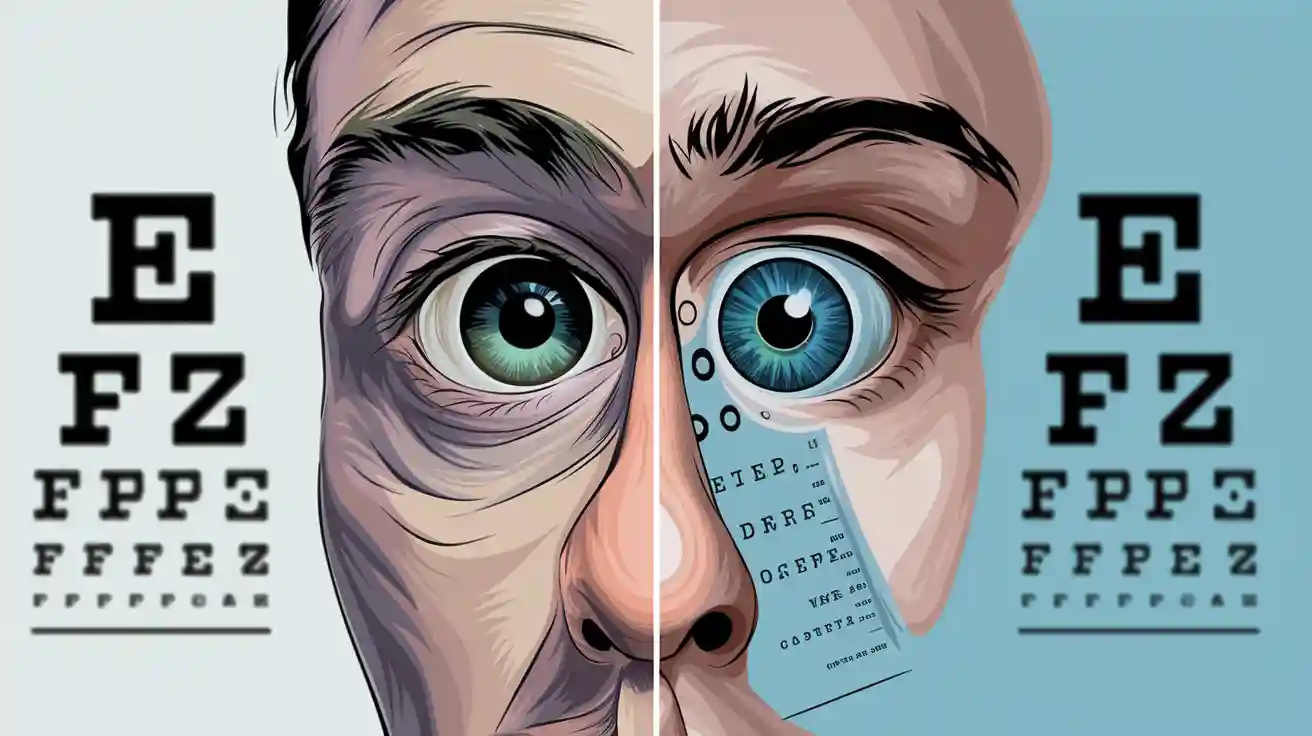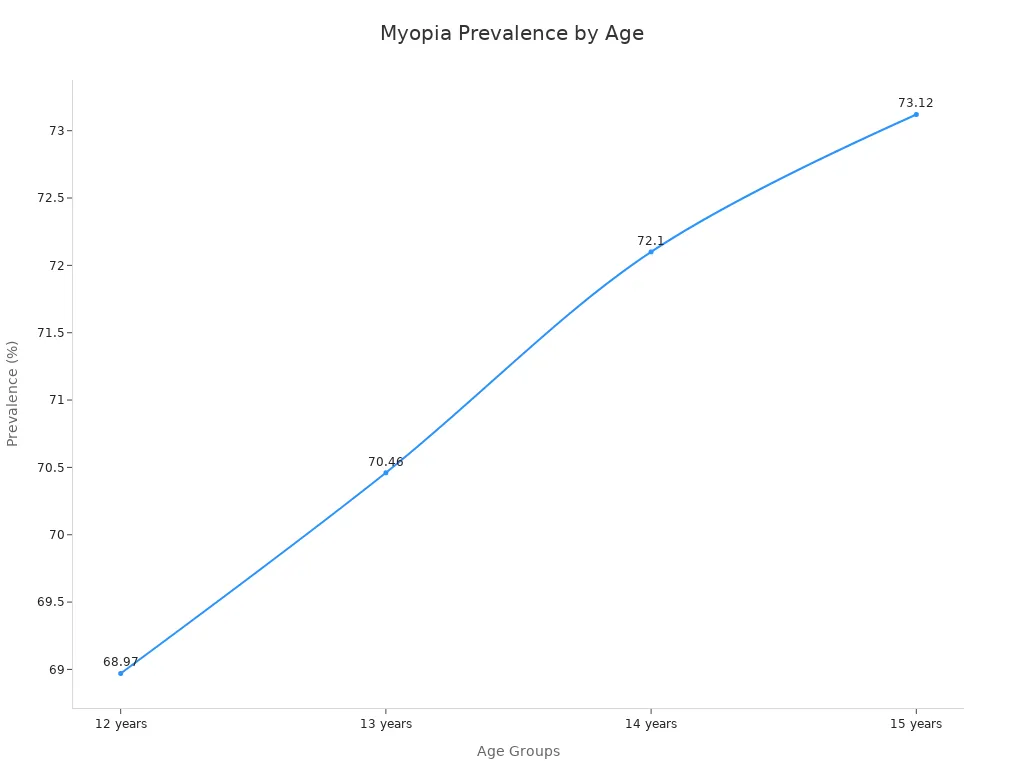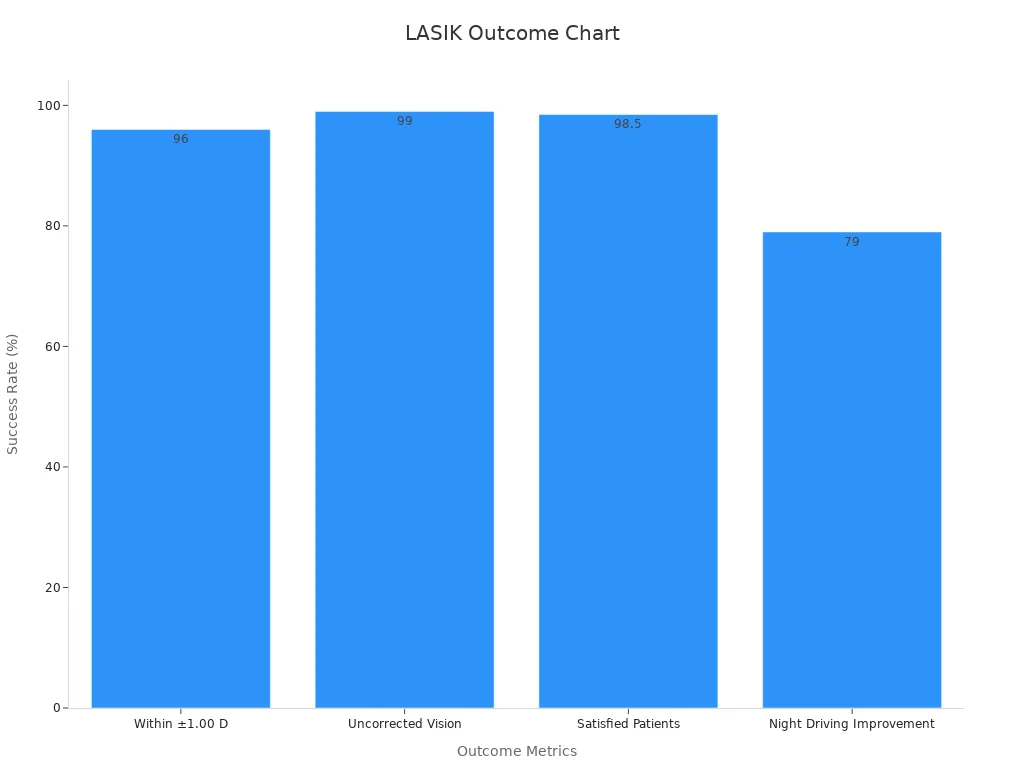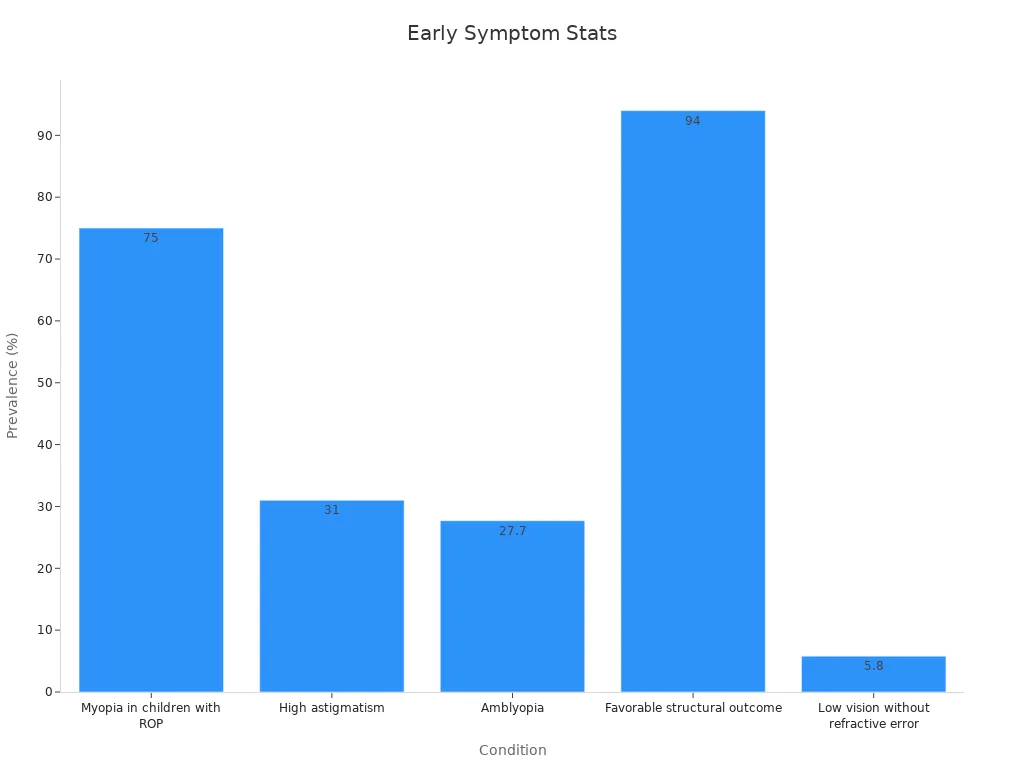
Astigmatism vs myopia describes two common ways eye conditions affect your vision. If you have astigmatism, you notice blurry vision at all distances, not just far away. Myopia, however, mostly makes distant objects unclear while close-up things stay sharp. Astigmatism is more common in adults worldwide, while myopia rates keep rising. Unlike myopia, astigmatism can stop you from having clear vision at all distances, making daily tasks harder.
Studies show astigmatism often leads to blurry vision at all distances, while myopia mainly affects your ability to see far away.
Key Takeaways
Astigmatism causes blurry vision at all distances due to an unevenly shaped cornea, while myopia mainly makes distant objects look blurry because the eye is too long.
Both conditions can happen together, making vision blurry near and far, so it is important to get an eye exam if you notice any vision problems.
Common symptoms include blurry vision, eye strain, headaches, and trouble seeing at night or far away, which can affect daily activities like reading and driving.
Early diagnosis through regular eye exams helps prevent worsening vision and allows for effective treatments like glasses, contact lenses, or surgery.
Treatments such as special lenses and LASIK surgery can improve vision and quality of life, with many people achieving clear sight and comfort.
Astigmatism vs Myopia
What Is Astigmatism?
Astigmatism is one of the most common forms of refractive errors of the eye. You have astigmatism when the front surface of your eye, called the cornea, is shaped more like a football than a basketball. This uneven curve causes light to focus on more than one point in your eye. As a result, you see blurry or distorted vision at all distances. Understanding astigmatism helps you know why you might struggle to see things clearly, whether they are near or far.
Astigmatism affects about 14.9% of children and 40.4% of adults.
The risk of astigmatism can change based on your age, ethnicity, and even where you live.
Myopia can increase your risk of certain types of astigmatism.
A recent study found that astigmatism is common in both eyes, but sometimes only one eye is affected. The amount of astigmatism you have can also change how well you see. If you have higher levels, you may notice more problems with vision clarity.
Aspect |
Details |
|---|---|
Clinical Definition |
|
High astigmatism: ≥3.00 diopters |
|
Most Common Axis Orientation |
With-the-rule astigmatism |
Prevalence in Adolescents |
13.9% |
What Is Myopia?
Myopia, also called nearsightedness, is another type of refractive error. If you have myopia, your eye is longer than normal. This shape causes light to focus in front of your retina instead of on it. You see nearby objects clearly, but things far away look blurry. Myopia is becoming more common, especially in young people living in cities.
In some parts of East and South-East Asia, up to 90% of teenagers have myopia.
In Europe, about 24% of people have myopia, with higher rates in young adults.
Myopia often starts between ages 7 and 16.
Astigmatism vs myopia shows how these two refractive errors affect your vision in different ways. Astigmatism blurs your vision at all distances, while myopia mainly makes it hard to see far away. Both are common, but their causes and effects are not the same. When you compare astigmatism vs myopia, you see that each condition changes how light enters your eye and how you see the world. Knowing the difference helps you understand your own vision and what to expect if you have one or both conditions.
Tip: Astigmatism vs myopia can happen together. If you notice blurry vision at all distances and trouble seeing far away, you might have both refractive errors.
Differences Between Astigmatism and Myopia
How Is Astigmatism Different from Myopia?
You may wonder how is astigmatism different from myopia. Both are refractive errors, but they change the way you see in unique ways. Astigmatism happens when your cornea or lens has an uneven shape, like a football instead of a basketball. This shape bends light unevenly, so your eye cannot focus light on one clear point. You see blurry or distorted images at all distances.
Myopia, also called nearsightedness, is different. Your eyeball is longer than normal or your cornea is too curved. Light focuses in front of your retina, not on it. You see nearby objects clearly, but things far away look blurry.
Astigmatism causes blurry or wavy vision at all distances.
Myopia mainly makes distant objects blurry, but near vision stays sharp.
Both conditions can happen together, making vision even more challenging.
If you have both astigmatism and myopia, you may notice blurry vision at all distances and extra trouble seeing far away.
Causes
The causes of astigmatism and myopia are not the same, but they can be related. Astigmatism usually comes from an irregularly shaped cornea or lens. This shape can be present at birth or develop as you grow. Myopia develops when your eyeball grows too long or your cornea becomes too steep. Genetics, eye growth, and even how much time you spend on close-up tasks can play a role.
Research shows that astigmatism can increase as myopia gets worse. In a long-term study, children with early astigmatism often developed more myopia as they grew older. Some scientists believe that having astigmatism early in life can change how your eye grows, leading to both conditions.
Condition |
Main Cause |
How It Changes the Eye |
|---|---|---|
Astigmatism |
Irregular cornea or lens shape |
Light bends unevenly, focus is unclear |
Myopia |
Elongated eyeball or steep cornea |
Light focuses in front of the retina |
How Each Affects Vision
Astigmatism and myopia both affect vision, but in different ways. Astigmatism blurs your vision at all distances. You may notice wavy lines, double images, or trouble seeing clearly in dim light. Myopia mostly affects your distance vision. You can read a book up close, but road signs far away look fuzzy.
Astigmatism bends light in many directions, so your eye cannot focus well at any distance.
Myopia bends light too much, so only close objects look clear.
Studies show that even mild astigmatism can make vision less sharp, especially if you already have myopia. Many people with myopia also need correction for astigmatism to see clearly. If you do not correct astigmatism, you may get headaches, eye strain, or trouble seeing at night.
Tip: If you notice blurry vision both near and far, you might have both nearsightedness and astigmatism. An eye doctor can test for both refractive errors and help you find the right treatment.
The differences between astigmatism and myopia matter because they change how you see the world. Astigmatism can make daily tasks like reading, driving, or using a computer harder. Myopia mostly makes it tough to see things far away, like the board at school or street signs. Both conditions can lower your quality of life if left untreated, but modern treatments can help you see clearly again.
Symptoms

Astigmatism Symptoms
You may notice several signs if you have astigmatism. The most common symptom is blurry vision at all distances. You might squint to see clearly, especially when reading or looking at screens. Many people with astigmatism feel eye strain or headaches after focusing for a long time. Night driving can become difficult because lights may look streaky or doubled. Some people see double images, called diplopia, even when only one eye is open. Studies show that about 13% of people with refractive errors have astigmatism. People with higher levels of astigmatism report blurry vision more often. You may also struggle with reading small print or seeing clearly in dim light.
If you always feel tired eyes or notice blurry vision, you could have astigmatism. An eye doctor can help you find out.
Symptom |
How It Feels |
|---|---|
Blurry vision |
Objects look fuzzy at all distances |
Eye strain |
Eyes feel tired or sore after reading or screen use |
Headaches |
Pain around the eyes or forehead |
Double vision |
Seeing two images instead of one |
Night vision problems |
Lights look streaky or doubled at night |
Myopia Symptoms
Myopia, or nearsightedness, causes different vision problems. You see nearby things clearly, but you have difficulty seeing objects at a distance. Blurry vision is the main symptom, especially when looking at road signs or the board at school. You may squint or blink a lot to try to see better. Headaches and eye strain are also common. Children with myopia often rub their eyes or sit close to the TV. About one third of people have myopia, and the number keeps rising, especially in cities and among teenagers.

Symptoms of myopia often start in childhood and can get worse as you grow.
Comparing Visual Experience
Astigmatism and myopia both cause blurry vision, but they affect your daily life in different ways. With astigmatism, you may notice blurry vision all the time, no matter how far away something is. You might see wavy lines or double images, making reading and driving harder. Myopia mostly causes blurry vision when you look at things far away. You can read a book up close, but faces across the room look fuzzy. If you have both conditions, you may struggle with blurry vision at every distance and have more severe vision problems. About 30% of people with myopia also have astigmatism, which can make symptoms worse. You may feel more eye strain, headaches, and trouble with depth perception.
If you notice blurry vision, headaches, or trouble seeing at night, you should get your eyes checked. Early treatment can help you avoid more serious vision problems.
Risks and Complications
Prevalence
You see different rates of myopia and astigmatism around the world. Myopia affects many young adults in East Asia, with rates reaching up to 90% in cities. In Singapore, more than half of 12-year-olds have myopia. In Europe and the United States, the numbers are lower, but still rising. For example, about 28% of young adults in the U.S. have myopia. Australia reports about 20% in young adults. Global studies estimate that nearly 2 billion people had myopia in 2016. This number may double by 2050. High myopia is also increasing, with almost 10% of the world’s population expected to have it by 2050. Reliable global data for astigmatism is not available, but you should know it remains common in both children and adults.
Potential Risks
If you leave myopia untreated, you face serious risks. High myopia can lead to retinal detachment, glaucoma, cataracts, and myopic maculopathy. For example, a woman with high myopia needed surgery for retinal detachment and cataracts, but her vision stayed poor. Children with early myopia and astigmatism can see their vision problems get worse over time. Studies show that children aged 7 to 12 with myopia benefit from early treatment. Special lenses and low-dose eye drops can slow down myopia progression. Astigmatism alone does not cause the same long-term risks as myopia, but it can make vision correction more complex.
Complications
You need to watch for complications if you have high myopia. These include:
Retinal detachment, which can cause sudden vision loss.
Cataracts, which may need surgery earlier than usual.
Glaucoma, with a risk nearly 50% higher in people with severe myopia.
Myopic maculopathy, which damages the center of your vision.
Complication |
Risk with High Myopia |
Notes |
|---|---|---|
Retinal detachment |
5-6 times higher |
Can cause permanent vision loss |
Cataracts |
17% more likely |
Surgery may be needed at a younger age |
Glaucoma |
Harder to detect early |
|
Myopic maculopathy |
Strong association |
Leads to central vision problems |
Astigmatism can make it harder to treat myopia, especially with certain lenses. You may notice more vision problems if you have both conditions. Early eye exams and treatment help prevent these complications and protect your sight.
Diagnosis and Treatment
Diagnosis
You can find out if you have astigmatism or myopia through a simple eye exam. Eye doctors use special tools to measure how your eyes focus light. Recent studies show that both photorefraction and cycloautorefraction work well for diagnosing these conditions. These tests agree more than 81% of the time and have high sensitivity and specificity. Doctors may also use a standardized refraction protocol in different lighting conditions to check for night myopia. This method measures how your vision changes in bright and dim light, making it easier to spot problems. These tests are safe, accurate, and easy to repeat, so you can trust the results.
Glasses and Contacts
Glasses and contact lenses are the most common ways to achieve vision correction for astigmatism and myopia. Glasses use special lenses to bend light correctly, helping you see clearly. Contact lenses, including toric and orthokeratology (ortho-k) lenses, can also correct both conditions. Ortho-k lenses reshape your cornea while you sleep, so you do not need glasses during the day. Studies show that ortho-k can slow myopia progression by up to 50%. Multifocal rigid gas permeable lenses also help control myopia and work well for people with high astigmatism.
Astigmatism Group (Cylinder D) |
Visual Acuity Success Rate (%) |
Overall Fitting Success Rate (%) |
Lens Fit Acceptability (%) |
Comfort Acceptability (%) |
Adverse Visual Symptoms Incidence (%) |
|---|---|---|---|---|---|
-0.75 to -0.50 |
100 |
93.72 |
>95 |
>97 |
<10 |
-1.75 to -1.00 |
98.58 |
90.78 |
>95 |
>97 |
<10 |
≤ -2.00 |
97.22 |
88.89 |
>95 |
>97 |
<10 |
You can expect high success rates and comfort with these options. Most people experience few side effects and enjoy better vision for daily activities.
Surgery and Other Options
If you want a long-term solution, you might consider surgery. LASIK is a popular choice for vision correction. It uses a laser to reshape your cornea, fixing both myopia and astigmatism. Advanced techniques like bitoric ablations make results more stable, especially for high astigmatism. Clinical studies show that 99% of patients reach 20/40 vision or better after LASIK, and 98.5% feel satisfied with their results. Most people report less trouble with night driving and glare.

Other options include toric and phakic intraocular lenses, which can help if you are not a good candidate for LASIK. These treatments give you a strong chance for clear vision and a better quality of life.
When to See an Eye Doctor
Recognizing Symptoms
You might not always notice changes in your vision right away. Blurry vision, headaches, or squinting can signal astigmatism or myopia. Children may sit close to the TV or hold books very near. Early recognition of these symptoms helps prevent long-term problems. Some children face a higher risk of vision issues, especially if they were born early or have a family history of eye problems.
Condition/Outcome |
Prevalence/Statistic |
Implication for Early Recognition |
|---|---|---|
Myopia in children with ROP |
High prevalence indicates need for early detection |
|
High astigmatism |
31% occurrence |
Significant risk factor requiring early intervention |
Amblyopia |
27.7% occurrence |
Early recognition critical to prevent long-term vision loss |
Favorable structural outcome |
94% |
Despite this, only 79% had favorable functional outcome |
Low vision without refractive error |
5.8% |
Suggests subnormal visual acuity syndrome, highlighting need for early follow-up |

Younger children, especially those under 12 months, have a higher chance of developing astigmatism. Children with myopia or hyperopia also face greater risks. Early detection and intervention can make a big difference in your child’s vision and learning.
Importance of Eye Exams
Regular eye exams help you catch vision problems before they get worse. Many people do not notice symptoms until their vision changes a lot. A 2016 study found that 58% of people without symptoms still needed changes to their eye care or had hidden eye diseases. Eye doctors can spot issues like astigmatism and myopia early, even if you feel fine.
The American Optometric Association recommends that children get their first eye exam at 6 months, again at 3 years, and then every two years from ages 6 to 18. Adults should have yearly check-ups. These exams help find refractive errors, monitor changes, and check for other health problems. Over 270 health conditions can show up in your eyes, so regular exams protect more than just your vision.
Tip: Early detection and treatment of astigmatism or myopia can prevent headaches, eye strain, and trouble learning in school. Regular eye exams keep your eyes healthy and your vision clear.
Astigmatism and myopia affect your vision in different ways. Astigmatism causes blurry vision at all distances, while myopia mainly makes far objects look unclear. You can see these differences in the table below:
Aspect |
Astigmatism |
Myopia |
|---|---|---|
Vision Impact |
Blurry at all distances |
Blurry far, clear near |
Cause |
Irregular cornea or lens shape |
Eye too long or steep cornea |
Recent clinical studies show that new contact lenses help most people with both conditions see clearly.
Regular eye exams and early treatment give you the best chance for healthy vision.
FAQ
Can you have both astigmatism and myopia at the same time?
Yes, you can have both. Many people have astigmatism and myopia together. You may notice blurry vision at all distances and extra trouble seeing far away. Your eye doctor can check for both and suggest the best treatment.
How do glasses correct astigmatism and myopia?
Glasses use special lenses to bend light correctly. For astigmatism, the lens has a unique shape. For myopia, the lens helps focus light on your retina. You get clear vision when you wear the right prescription.
Will astigmatism or myopia get worse over time?
Both conditions can change as you grow. Myopia often gets worse during childhood and teenage years. Astigmatism can also change, but usually more slowly. Regular eye exams help you track changes and update your prescription.
Can you prevent astigmatism or myopia?
You cannot always prevent these conditions. Genetics play a big role. Spending time outdoors and taking breaks from screens may help slow myopia in children. Early eye exams help you catch problems and start treatment quickly.






